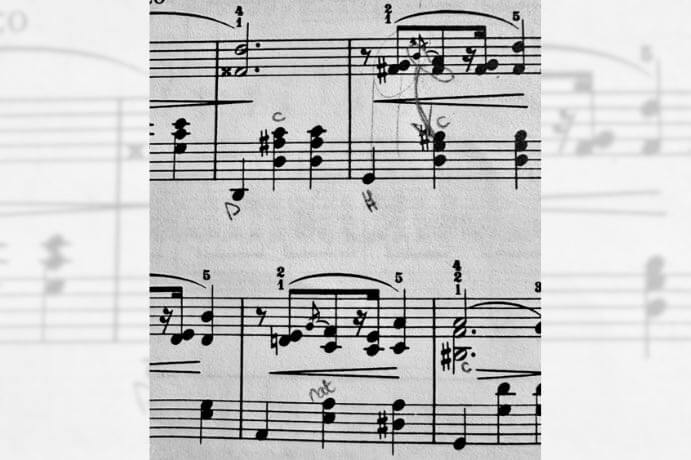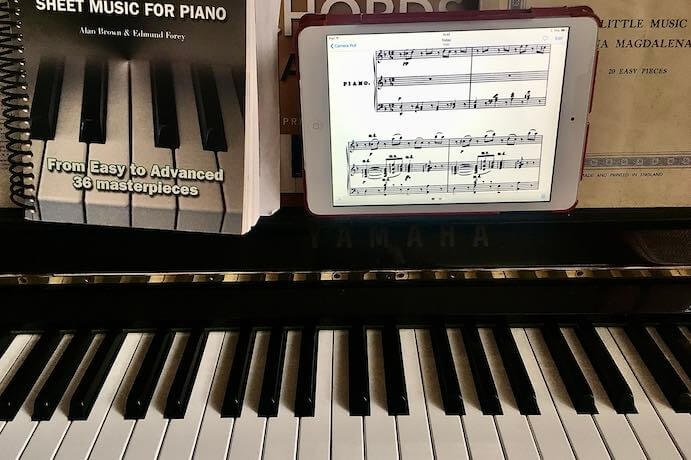At the drama school in London where I was a student from ages 11 to 15, there was an abundance of unattended upright pianos. I never missed an opportunity to get in some extra practice before my piano lessons on Thursdays, so I would steal myself away in a corner of the academy where we learned to tap dance, hiding amongst the cacophony of their mass rehearsal so my own stuttering attempts to pick out that tricky fourth bar of Chopin’s G Minor Mazurka was only safely audible to me.
I remember being randomly interrupted by my mathematics teacher once. “I didn’t know you could play,” he said, obviously surprised. “Yes.” I replied. “I don’t play in public.”
There is a clear link between mathematics and music – two mediums of symbols, relayed in an order that resolves itself, with a clear beginning, middle and end. Both also had the power to make me feel like I wasn’t smart. I would later be removed from that teacher’s algebra lesson for an ‘appointment:’ it was the educational psychologist, testing me again for signs of NVLD, which they had initially found at age eight.
Nonverbal Learning Disorder (NVLD) is on the spectrum of neurodivergence, a term coined by Australian psychologist Judy Singer in the late 90s. NVLD can be confused with Autism and ADHD as there can be similarities, and the disorder has no catch-all definition. However, it does manifest as a desire for routine, an inability to manage sudden change, and difficulty grasping concepts that aren’t relayed by words, making simple tasks complicated: map reading, reading a clock, mathematics, and of course, music. Similar to a kind of numerical dyslexia, it prominently features a lack of understanding of symbols and numbers and is diagnosed as such.
All of this was unknown to me as I sat down at the piano in my teacher’s apartment in 1998. I was bred for music – I grew up listening to my sister’s mesmeric performances of Bach on the jet black upright Yamaha in our home, and the classical and jazz piano recordings my parents played for us kids. At age seven, when I was asked if I wanted classical piano lessons, I jumped at the chance. For a few years, I was happy with my little learners’ books, labelling the letters of the keyboard as words, spelling out ‘B E,’ ‘C A B,’ – even nonsense words like ‘G A D’ were welcome, as comparable to reading as it was. And reading was my favourite.
But soon, in came music theory and out went the words: replaced with squiggles, sharps, flats, and Italian words, all in a never ending parade – it was like suddenly being told to become fluent in another language overnight. I struggled terribly with five note chords of only the right hand, painstakingly trying to find which note was marked with a sharp in uncomfortable silence for over a decade, keenly aware of the money my parents were spending for me to not get this, and finally understanding that I would never improve seriously beyond those learners books – all while my teacher perpetually looked on, the air thick with expectation.

A snapshot of Jessica’s sheet music, marked with pencil annotations — Photo courtesy of the author
My piano teacher was superbly talented, but was also relentlessly traditional for someone so young, often labelling my difficulty as annoying and lazy. By my teenage years, music was humbling, a near-chore, and incredibly hard work that I no longer had time for alongside my other studies. In my childish optimism and excitement, I suspect I may have harboured the dream of being a professional pianist, but every contact I had with the study, theory, and industry of classical music had resolutely told me no.
As someone with a diagnosed learning disorder, the inaccessibility of classical music came as a two-pronged attack: impenetrable on the page, and exacting and exalted in the schools. Musical notation stubbornly exists in the form it was conceived – believed to be founded by 11th century Tuscan monk Guido from Arezzo – making it hard to defend against allegations of being outdated, elitist, and neuronormative. When learning to read conventional music notation, there is a frustrating glass ceiling for people with conditions like NVLD, and the lack of alternatives make classical music feel like something that is earned, not learned. At times, my studies truly felt like punishment – like some kind of strange penance had to be paid: sweat that same dedication, burnout, and trauma as those “great” composers of the past, or it doesn’t count.
In the end, I relied on my ear to learn how to play the most famous pieces put in front of me – truly, if you listen to recordings of Fur Elise enough, you get the gist, as this study reinforces. My pesky work around annoyed my teacher enormously, of course, but muscle memory also had its early adopters: If Clara Schumann could do it by muscle memory, so could I. Today, I still have a modest programme in my fingers: preludes, that mazurka, a few choice waltzes squirrelled away for a rainy day. If I’m in the right mood, I can sit down at a piano and play like a switch has been turned on. I used to be embarrassed by that – but I’m proud I adapted and found a way to play the music that I so loved listening to as a child. Playing music became recreational, not the cerebral pursuit deemed acceptable by the institution of classical music. Sitting down at the piano was finally, finally – fun.

A scene from Jessica’s piano bench — Photo courtesy of the author
But as long as we continue to present conventional notation as the only means of learning classical music, it will remain inaccessible to many. In order to remove barriers to participation, new pedagogical methods and accessible notation practices are needed. A starting point is revising our teacher training to make music educators more aware of a spectrum of different learning needs; if public schools have committed to equipping educators with tools for teaching neurodivergent children, let it also be so for the piano tutors and lecturers.
In addition to training more mindful educators, adapted music notation of the classical repertoire would make a significant difference. I can only speak for the NVLD pianists, but the change would be instant if we could replace the notation in the score with letters so they match the names of the keys. There is, after all, precedent in the tutoring of pre-grade students that would definitely support NVLD students’ need to read notes like they would read the alphabet.
Accidental markings and other symbolic languages are also difficult to decipher, which could be remedied by simply stating that the third note ascending in the chord has a sharp typed on the page, saving much time and angst. Streamlining the whole sheet reading experience by writing expressive markings in the native language of the student would also remove that little extra moment of calibration needed to translate from Italian, French, or German.
These measures to increase accessibility seem like they should be an easy fix in 2024. Perhaps leveraging technology that already exists could help reimagine and re-programme the sheet music model. There is already software like Lime Lighter that can enhance the notation more than 20x for visually impaired musicians, and special keyboards such as the Odla console are providing tactile alternatives to composing digital scores that mimic the ‘qwerty’ keyboard.
There is of course much to be said about the dated nature of piano examinations, too: removing sight reading tests would do a great deal to downplay the importance of sheet music and ease our reliance on it as the only mode of study. The fear I felt knowing I couldn’t sound out the music for myself in such a high-pressure situation was yet another barrier to face as a young neurodivergent piano student. And for those who bypass music notation entirely: pianists that are able to visually ‘pick up’ Rachmaninov from watching YouTube videos of pianists hands, getting to the same level of performance as the conservatory and academy pianists – they should be afforded the same stages for their talents.
My hope is that the next generation of NVLD and neurodivergent pianists will be given a fair chance, and for comprehension and opportunity to no longer be reliant on ability, money, or tradition.
Here in the UK, the influx of pianos in public train stations is a great start, showing there is an audience for classical music that goes beyond the Proms or institutions. Will there be academic, grey-haired backlash to allowing more people to engage with the artform? Inevitably so. After all, lack of accessibility is institutionalised, and gatekeeping is learned, especially as older generations continue to mythologise long-dead musicians and brand them as untouchable. But a conversation is a good start.
I’m both a student and a survivor of classical music pedagogy, and I am proof that learning and making music can have such a positive effect on mental health, equipping students with a coping mechanism that can serve them throughout their lives. I’ve managed to rehab myself by listening and going to concerts, and I am very lucky to feel like a VIP when I watch: I recognise their movements; how their faces scrunch up with passion, how they lift off the keys with finality – I know this dance, too, in my own way.
Ultimately, I didn’t become a concert pianist, but I can pretend pretty well, listen to a melody and pick it out on that old Yamaha – I found my relationship with the piano, and I’m happy. But my hope is that the next generation of NVLD and neurodivergent pianists will be given a fair chance, and for comprehension and opportunity to no longer be reliant on ability, money, or tradition. After all, music is free: we only get to rent it for a short time, and everyone should get a shot at the bliss that only 88 keys at your beck and call can bring.
I CARE IF YOU LISTEN is an editorially-independent program of the American Composers Forum, and is made possible thanks to generous donor and institutional support. Opinions expressed are solely those of the author and may not represent the views of ICIYL or ACF.
You can support the work of ICIYL with a tax-deductible gift to ACF. For more on ACF, visit the “At ACF” section or composersforum.org.



















